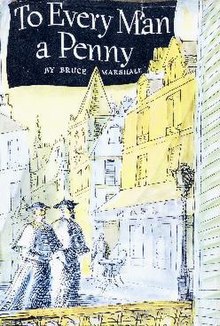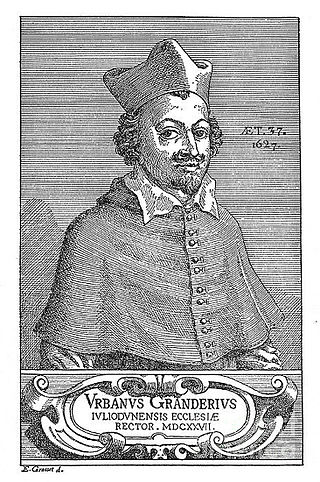
Urbain Grandier was a French Catholic priest who was burned at the stake after being convicted of witchcraft, following the events of the so-called "Loudun possessions". Most modern commentators have concluded that Grandier was the victim of a politically motivated persecution led by the powerful Cardinal Richelieu.
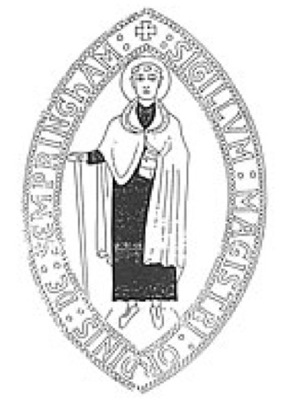
The Gilbertine Order of Canons Regular was founded around 1130 by Saint Gilbert in Sempringham, Lincolnshire, where Gilbert was the parish priest. It was the only completely English religious order and came to an end in the 16th century at the time of the Dissolution of the Monasteries. Modest Gilbertine revivals have taken place in the late 20th and early 21st centuries on three continents.

Carfin Lourdes Grotto, a Roman Catholic shrine in Scotland dedicated to Our Lady of Lourdes, was created in the early twentieth century. The "Carfin Grotto", as the shrine is locally referred to, was the brainchild of Father, later Canon Thomas N. Taylor, parish priest of St. Francis Xavier's Parish in the small, mining village of Carfin, which lies two miles east of Motherwell, in the West of Scotland. Following a trip to France's principal Marian shrine at Lourdes, Canon Taylor's vision was to build a religious memorial in honour of Our Blessed Lady based on the template of the Grotto of Massabielle. To realize this vision became his life's work. Since its opening in the early 1920s, the "grotto" has attracted pilgrims in the hundreds of thousands and its environs have been modified and enhanced with rich Catholic symbols and buildings. The grotto shrine offers a pilgrimage season with Sunday processions, rosaries, outdoor Masses and dedicated Feast Day events which run annually from early May until late September.

Mother Joan of the Angels is a 1961 Polish art film on demonic possession, directed by Jerzy Kawalerowicz, based on a novella of the same title by Jarosław Iwaszkiewicz, loosely based on the 17th century Loudun possessions. The film won the Special Jury Prize at the 1961 Cannes Film Festival.

Lieutenant-Colonel Claude Cunningham Bruce Marshall, known as Bruce Marshall was a prolific Scottish writer who wrote fiction and non-fiction books on a wide range of topics and genres. His first book, A Thief in the Night came out in 1918, possibly self-published. His last, An Account of Capers was published posthumously in 1988, a span of 70 years.
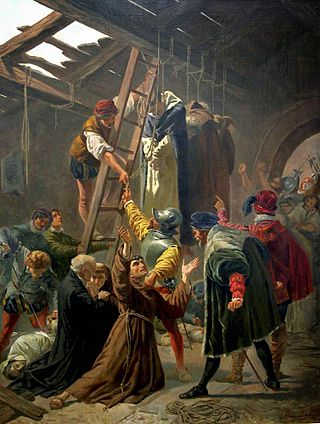
The Martyrs of Gorkum were a group of 19 Dutch Catholic clerics, secular and religious, who were hanged on 9 July 1572 in the town of Brielle by militant Dutch Calvinists during the 16th-century religious wars—specifically, the Dutch Revolt against Spanish rule, which developed into the Eighty Years' War.
The Aix-en-Provence possessions were a series of alleged cases of demonic possession occurring among the Ursuline nuns of Aix-en-Provence in 1611. Father Louis Gaufridi was accused and convicted of causing the possession by a pact with the devil, and he was tortured by strappado and his bones dislocated. He was then executed on April 1611 by strangulation and his body burned. This case provided the legal precedent for the conviction and execution of Urbain Grandier at Loudun more than 20 years later. This event led to possessions spreading to other convents and a witch burning in 1611.

The Loudun possessions, known in French as the Possessed of Loudun Affair, was a notorious witchcraft trial that took place in Loudun, Kingdom of France, in 1634. A convent of Ursuline nuns said they had been visited and possessed by demons. Following an investigation by the Catholic Church, a local priest named Urbain Grandier was accused of summoning the evil spirits. He was eventually convicted of the crimes of sorcery and burned at the stake.

The priesthood is the office of the ministers of religion, who have been commissioned ("ordained") with the Holy orders of the Catholic Church. Technically, bishops are a priestly order as well; however, in layman's terms priest refers only to presbyters and pastors. The church's doctrine also sometimes refers to all baptised (lay) members as the "common priesthood", which can be confused with the ministerial priesthood of the consecrated clergy.
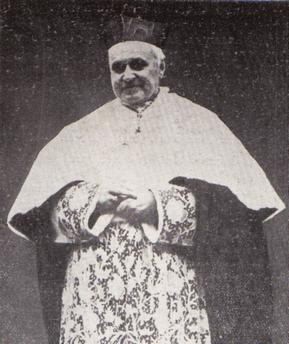
Emmanuel Célestin Suhard was a French cardinal of the Catholic Church. He served as Archbishop of Paris from 1940 until his death, and was elevated to the cardinalate in 1935. He was instrumental in the founding of the Mission of France and the worker-priest movement, to bring the clergy closer to the people.
MonsignorMichel-Gaspard Coppenrath was the Tahitian Archbishop of the Roman Catholic Archdiocese of Papeete in French Polynesia for 26 years from 1973 until 1999. Coppenrath served as the Archbishop Emeritus of the Roman Catholic Archdiocese of Papeete from 1999 until his death in 2008. Coppenrath was the first Tahitian-born Catholic bishop of French Polynesia.

A Thread of Scarlet is a 1959 novel by Scottish writer Bruce Marshall.
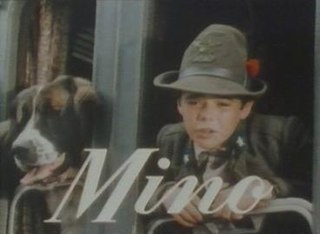
Mino was the eighth ZDF-Weihnachtsserie, and aired in 1986. The series was broadcast in Germany on ZDF, and consisted of 6 episodes. Broadcasting in Germany began on December 25, 1986. The series was also broadcast in Italy, and consisted of 4 episodes. Broadcasting in Italy began on December 28, 1986. The series was an Italian-German co-production. It was inspired by the Italian novel The little Alpino by Salvator Gotta.
The Polish anti-religious campaign was initiated by the communist government in Poland which, under the doctrine of Marxism, actively advocated for the disenfranchisement of religion and planned atheisation. To this effect the regime conducted anti-religious propaganda and persecution of clergymen and monasteries. As in most other Communist countries, religion was not outlawed as such and was permitted by the constitution, but the state attempted to achieve an atheistic society.

Father Francis Gleeson was an Irish Roman Catholic priest who served as a British Army chaplain during Ireland's involvement in the First World War. Educated at seminaries near Dublin, Gleeson was ordained in 1910 and worked at a home for the blind before volunteering for service upon the outbreak of war. Commissioned into the Army Chaplains' Department and attached to the 2nd Battalion, Royal Munster Fusiliers he served with them at the First Battle of Ypres. During this battle Gleeson is said to have taken command of the battalion after all the officers were incapacitated by the enemy. He was highly regarded by his men for tending to the wounded under fire, visiting the frontline trenches, and bringing gifts.

María de las Maravillas de Jesús, OCD, in some contexts known as Maravillas de Jesús, was a Spanish Discalced Carmelite. She founded several houses of her order and even set one up in India after serving a brief exile with other Carmelites due to the outbreak of the Spanish Civil War.
Franz Alexander Kern, also known by his religious name Jakob, was an Austrian Roman Catholic priest and a professed member from the Premonstratensians. Kern served as a soldier in the Austro-Hungarian armed forces during World War I and suffered threatening injuries that impeded his health for the remainder of his life and which often hampered his studies. He fostered an intense devotion for the Eucharist - for which he was known - and was often found in constant Eucharistic Adoration.
Marina Hociotă, also known as Mina Hociotă, was a Romanian nun who acted as a front line nurse during World War I.

Petar Čule was a prelate of the Catholic Church who served as the bishop of Mostar-Duvno and of apostolic administrator of Trebinje-Mrkan from 1942 until his retirement in 1980. After his retirement, he was named titular archbishop of Giufi in present-day Tunisia. Serving as bishop during World War II, Čule was an opponent of the Ustaše regime in the Independent State of Croatia, helping to save the persecuted Serbs and political dissidents. Imprisoned under false accusations by the communists in 1948 and released only in 1955, he was also a political victim of communist political persecution.

Reginald St John Beardsworth Battersby was, at the age of 15, the youngest known commissioned officer of the British Army of the First World War. He enlisted in the Manchester Regiment at the age of 14 and was promoted to lance corporal within a week. When his father realised what Battersby had done, he intervened and had him commissioned as an officer in the East Lancashire Regiment. Battersby was wounded in action leading a platoon over the top on the first day of the Somme but returned to duty to fight in the 1917 Operations on the Ancre. It was here that he was struck by shrapnel from a German shell, resulting in the amputation of his left leg. Battersby was asked to resign his commission owing to disability but insisted he could still be of use to the army if fitted with a prosthetic leg and successfully returned to duty with a Royal Engineers transport unit. After the war he studied theology and became a vicar at Chittoe, Wiltshire. During the Second World War he organised the local Home Guard unit and between 1943 and 1945 served as a chaplain to the Royal Marines at Chatham Dockyard.
